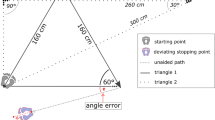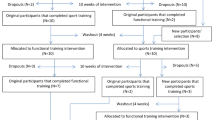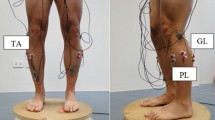Summary
Twenty-seven children (age 7–17 years) with varying degrees of blindness but with no other known disorder were assessed for physical fitness. Twenty-seven randomly selected children with normal eyesight were also assessed. Maximum oxygen uptake (\(\dot V_{{\text{O}}_{{\text{2 max}}} } \)) was measured directly during a progressive exercise test on a treadmill. There was a significant and substantial reduction in\(\dot V_{{\text{O}}_{{\text{2 max}}} } \) in totally blind children (mean ± standard deviation 35.0±7.5 ml · min−1 · kg−1) compared with normal children (45.9±6.6 ml · min−1 · kg−1). Partially sighted children had a significant but smaller reduction in\(\dot V_{{\text{O}}_{{\text{2 max}}} } \). Fitness assessed by a step-test was significantly reduced in the visually impaired children, and skin-fold thickness was also significantly greater in totally blind children.
The level of habitual physical activity for each child, as assessed by a questionnaire, correlated with\(\dot V_{{\text{O}}_{{\text{2 max}}} } \) (r=0.53,p<0.0001). Blind children were significantly less active than normal children, and the difference between mean\(\dot V_{{\text{O}}_{{\text{2 max}}} } \) for blind and normal children became non-significant when their different activity levels were taken into account. It is concluded that totally blind children are less fit than other children at least partly because of their lower level of habitual activity.
Similar content being viewed by others
References
Astrand P-O, Rodahl K (1977) Textbook of work physiology. McGraw-Hill, New York
Atomi K, Iwaoka K, Hatta H, Miyashiti M, Yamamoto Y (1986) Daily physical activity levels in preadolescent boys related to\(\dot V_{{\text{O}}_{{\text{2 max}}} } \) and lactate threshold. Eur J Appl Physiol 55:156–161
Bjorntorp P, Krotkiewski M (1985) Exercise treatment in diabetes mellitus. Acta Med Scand 217:3–7
Cartmel JL, Banister EW (1969) The physical working capacity of blind and deaf school children. Can J Physiol Pharmacol 47:833–836
Chave SPW, Morris JN, Moss S, Semmence AM (1978) Vigorous exercise in leisure time and the death rate: a study of male civil servants. J Epidemiol Community Health 32:239–243
Cumming GR, Goulding D, Baggley G (1971) Working capacity of deaf, and visually and mentally handicapped children. Arch Dis Childhood 46:490–494
Henriksen JM, Toftegaard Nielsen T, Dahl R (1981) Effects of physical training on plasma citrate and exercise-induced asthma. Scand J Clin Lab Invest 41:225–229
Johnson ML, Burke BS, Mayer J (1956) Relative importance of inactivity and overeating in the energy balance of obese high school girls. Am J Clin Nutr 4:37–44
Kemper HCG, Verschuur R, Ras KGA, Snel J, Splinter PG, Tavecchio LWC (1975) Biological age and habitual activity in relation to physical fitness in 12–13 year old schoolboys. Z Kinderheilk 119:169–179
Klissouras V (1971) Heritability and adaptive variation. J Appl Physiol 31:338–344
Mayer J (1956) Relation between calorie intake, body weight and physical work. Am J Clin Nutr 4:169–175
Paffenbarger RS, Hyde RT, Wing AL, Steinmetz CH (1984) A natural history of athleticism and cardiovascular health. J Am Med Assoc 252:491–495
Rowland TW (1985) Aerobic response to endurance training in prepubescent children: a critical analysis. Med Sci Sports Exer 17:493–497
Shephard RJ, Bailey DA, Mirwald RL (1976) Development of the Canadian Home Fitness Test. Cana Med Assoc J 114:675–679
Siegel W, Blomqvist G, Mitchell JH (1970) Effects of a quantitated physical training programme on middle-aged sedentary men. Circulation 41:19–29
Sundberg S (1982) Maximal oxygen uptake in relation to age in blind and normal boys and girls. Acta Paediatr Scand 71:603–608
Svenonius E, Kautto R, Arborelius M (1983) Improvement after training of children with exercise-induced asthma. Acta Paediatr. Scand 72:23–30
Wilson PG, Russell DG (1985) The national fitness survey: the pilot study. NZ J Health Phys Ed Rec 18:15–22
Author information
Authors and Affiliations
Rights and permissions
About this article
Cite this article
Hopkins, W.G., Gaeta, H., Thomas, A.C. et al. Physical fitness of blind and sighted children. Europ. J. Appl. Physiol. 56, 69–73 (1987). https://doi.org/10.1007/BF00696379
Accepted:
Issue Date:
DOI: https://doi.org/10.1007/BF00696379




